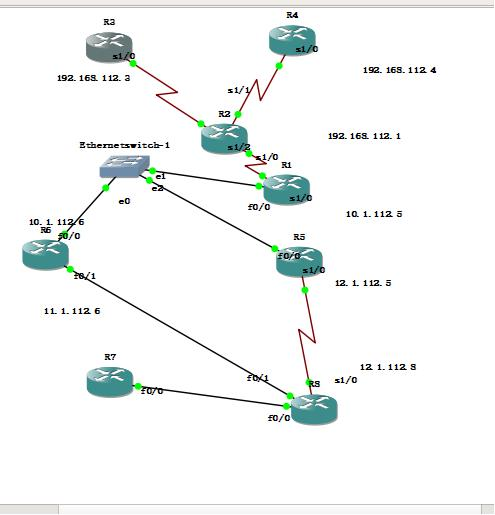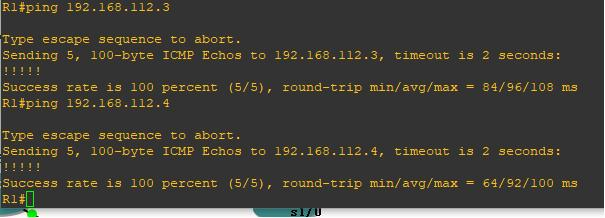IPv6 路由-OSPFv3
实验目的
1. 掌握 OSPFv3 的配置方法
2. 掌握在帧中继环境下 OSPFv3 的配置方法
3. 掌握 OSPFv3 NSSA 的配置方法
4. 掌握外部路由汇总的配置
5. 掌握区域间路由的汇总配置
实验拓扑图

IPv4地址表
| Device |
Interface |
IP Address |
| R1 |
F 0/0 |
10.1.112.1 |
| S 1/0 |
192.168.112.1 |
|
| R3 |
S 1/0 |
192.168.112.3 |
| R4 |
S 1/0 |
192.168.112.4 |
| R5 |
F 0/0 |
10.1.112.5 |
| S 1/0 |
12.1.112.5 |
|
| R6 |
F 0/0 |
10.1.112.6 |
| F 0/1 |
11.1.112.6 |
|
| R8 |
F 0/1 |
11.1.112.8 |
| S 1/0 |
12.1.112.8 |
步骤1:开启帧中继交换功能
R2(config)#frame-relay switching
步骤2:配置接口封装
R2(config)#int s 1/2
R2(config-if)#no shutdown
R2(config-if)#clock rate 128000
R2(config-if)#encapsulation frame-relay
R2(config)#int s 1/0
R2(config-if)#no shutdown
R2(config-if)#clock rate 128000
R2(config-if)#encapsulation frame-relay
R2(config)#int s 1/1
R2(config-if)#no shutdown
R2(config-if)#clock rate 128000
R2(config-if)#encapsulation frame-relay
(3) 步骤3:配置LMI类型
R2(config)#int s 1/2
R2(config-if)#frame-relay lmi-type cisco
R2(config-if)#frame-relay intf-type dce
R2(config)#int s 1/0
R2(config-if)#frame-relay lmi-type cisco
R2(config-if)#frame-relay intf-type dce
R2(config)#int s 1/1
R2(config-if)#frame-relay lmi-type cisco
R2(config-if)#frame-relay intf-type dce
(4) 步骤4:配置帧中继交换表
R2(config)#int s 1/2
R2(config-if)#frame-relay route 103 interface s 1/0 301
R2(config-if)#frame-relay route 104 interface s 1/1 401
R2(config)#int Serial 1/0
R2(config-if)#frame-relay route 301 interface Serial1/2 103
R2(config)#int Serial 1/1
R2(config-if)#frame-relay route 401 interface Serial1/2 104
此时“show frame-relay route”
检查帧中继交换机是否正常

(5)步骤5:配置R1、R3、R4,使得它们能够互相通信
R1(config)#int s 1/0
R1(config-if)#ip address 192.168..112.1 255.255.255.0
R1(config-if)#no shutdown
R1(config-if)#encapsulation frame-relay
R1(config-if)#frame-relay lmi-type cisco
R1(config-if)#no frame-relay inverse-arp //关闭自动映射
R1(config-if)#frame-relay map ip 192.168.112.3 103 broadcast
R1(config-if)#frame-relay map ip 192.168.112.4 104 broadcast
R3(config)#int s 1/0
R3(config-if)#ip address 192.168.81.3 255.255.255.0
R3(config-if)#no shutdown
R3(config-if)#encapsulation frame-relay
R3(config-if)#no frame-relay inverse-arp
R3(config-if)#frame-relay map ip 192.168.112.1 301 broadcast
R4(config)#int s 1/0
R4(config-if)#ip address 192.168.112.4 255.255.255.0
R4(config-if)#no shutdown
R4(config-if)#encapsulation frame-relay
R4(config-if)#no frame-relay inverse-arp
R4(config-if)#frame-relay map ip 192.168.112.1 401 broadcast
进行ping命令测试
从R1ping到R3与R4

R1#show frame-relay map
发现已有两条本地连接

步骤6:开始配置ospf
先配置外部路由器ospf (R6、R1为例,R5.R8同理)
R6(config)#router ospf 1
R6(config-router)#router-id 6.6.6.6
R6 (config-router)#area 1 nssa――配置区域 1 为 NSSA 区域
R6(config)#interface loopback 0
R6(config-if)#ip add 6.6.6.6 255.255.255.255
R6(config)#int f 0/0
R6(config-if)#ip add 10.1.112.6 255.255.255.0
R6(config-if)#no shut
R6(config-if)#ip ospf 1 area 0
R6(config-if)#int f 0/1
R6(config-if)#ip add 11.1.112.6 255.255.255.0
R6(config-if)#no shut
R6(config-if)#ip ospf 1 area 0
R6(config-if)#ex
R6(config)#router ospf 1
R6(config-router)#network 6.6.6.6 0.0.0.0 area 0
R6(config-router)#network 10.1.112.0 0.0.0.255 area 0
R6(config-router)#network 11.1.112.0 0.0.0.255 area 0
R1(config)#router ospf 1
R1(config-router)#router-id 1.1.1.1
R1(config)#interface loopback 0
R1(config-if)#ip add 1.1.1.1 255.255.255.255
R1(config)#int f 0/0
R1(config-if)#ip add 10.1.112.1 255.255.255.0
R1(config-if)#no shut
R1(config-if)#ip ospf 1 area 0
R1(config-if)#int s 1/0
R1(config-if)#ip ospf 1 area 0
R1(config-if)#ex
R1(config)#router ospf 1
R1(config-router)#network 1.1.1.1 0.0.0.0 area 0
R1(config-router)#network 10.1.112.0 0.0.0.255 area 0
R1(config-router)#network 192.168.112.0 0.0.0.255 area 0
R1(config-router)#neighbor 192.168.112.3
R1(config-router)#neighbor 192.168.112.4
步骤7:配置帧中继中路由器的ospf (R3为例,R4同理)
R3(config)#router ospf 1
R3(config-router)#router-id 3.3.3.3
R3(config-router)#ex
R3(config)#int loopback 0
R3(config-if)#ip add 3.3.3.3 255.255.255.255
R3(config-if)#ip ospf 1 area 2
R3(config-if)#int s 1/0
R3(config-if)# ip ospf 1 area 2
R3(config-if)# ip ospf priority 0
R3(config)#router ospf 1
R3(config-router)#network 3.3.3.3 0.0.0.0 area 2
R3(config-router)#network 192.168.81.0 0.0.0.255 area 2
已完成OSPFv2配置,在R1上查ospf邻居关系
R1#show ipv6 ospf neighbor

测试路由通断情况
在R5上测试得出结果如下(从内部到外部皆ping通,实验完成)
因为RIPNG是针对IPV6设计的一种路由协议,不支持IPV4,所以在OSPFv2里并没有做RIPNG路由配置。
Ospfv3配置
拓扑图

IPv6地址表
| Device |
Interface |
IPv6 Address |
| R1 |
F 0/0 |
2123::12:1/64 |
| S 1/0.1 |
2356::12:1/64 |
|
| Loopback 0 |
2011::1/128 |
|
| R3 |
S 1/0.1 |
2356::12:3/64 |
| Loopback 0 |
2033::1/128 |
|
| R3 |
S 1/0.1 |
2356::12:3/64 |
| Loopback 0 |
2044::1/128 |
|
| R5 |
F 0/0 |
2123::12:5/64 |
| S 1/0 |
2027::12:5/64: |
|
| Loopback 0 |
2055::1/128 |
|
| R6 |
F 0/0 |
2123::12:6/64 |
| Loopback 0 |
2066::1/128 |
|
| Loopback 1 |
2166::1/128 |
|
| R8 |
S 1/0 |
2027::12:8/64: |
| Loopback 0 |
2088::1/128 |
帧中继R2配置与ospfv2相同。
1.完成接口 IPv6 地址的配置,注意不要忘记配置 loopback0
:
R1(config)#ipv6 unicast-routing ―――全局打开 IPv6 路由功能
R1config)#interface loopback 0
R1(config-if)#ipv6 enable
R1(config-if)#ipv6 address 2011::1/128―――配置 loopback0 接口地址
R1(config-if)#int f 0/0
R1(config-if)#ipv6 enable
R1(config-if)# ipv6 address 2123::12:1/64
R1(config-if)#no shut
R1(config-if)#int s 1/0
R1(config-if)#ipv6 enable
R1(config-if)# encapsulation frame-relay
R1(config-if)#no shut
R1(config)#interface serial 1/0.1 multipoint
R1(config-subif)#ipv6 address 2356::12:1/64
R1(config-subif)#frame-relay map ipv6 2356::12:3 103 broadcast
R1(config-subif)#frame-relay map ipv6 2356::12:4 104 broadcast
R1(config-subif)#frame-relay map ipv6 2356::12:1 104 broadcast
R1(config-subif)#frame-relay map ipv6 FE80::C804:1CFF:FE48:8 104 broadcast
R1(config-subif)#frame-relay map ipv6 FE80::C803:1CFF:FE48:8 103 broadcast
R3(config)#ipv6 unicast-routing
R3(config)#interface loopback 0
R3(config-if)#ipv6 address 2033::1/128
R3(config-if)#int s 1/0
R3(config-if)#ipv6 enable
R3(config-if)# encapsulation frame-relay
R3(config-if)#no shutdown
R3(config)#interface serial 1/0.1 multipoint
R3(config-subif)#ipv6 address 2356::12:3/64
R3(config-subif)#frame-relay map ipv6 2356::12:1 301 broadcast
R3(config-subif)#frame-relay map ipv6 2356::12:4 301 broadcast
R3(config-subif)#frame-relay map ipv6 2356::12:3 301 broadcast
R3(config-subif)#frame-relay map ipv6 FE80::C804:1CFF:FE48:8 304 broadcast
R3(config-subif)#frame-relay map ipv6 FE80::C801:1CFF:FE48:8 301 broadcast
R4(config)#ipv6 unicast-routing
R4(config)#interface loopback 0
R4(config-if)#ipv6 address 2044::1/128
R4(config-if)#int s 1/0
R4(config-if)#ipv6 enable
R4(config-if)# encapsulation frame-relay
R4(config-if)#no shutdown
R4(config)#interface serial 1/0.1 multipoint
R4(config-subif)#ipv6 address 2356::12:4/64
R4(config-subif)#frame-relay map ipv6 2356::12:1 401 broadcast
R4(config-subif)#frame-relay map ipv6 2356::12:4 401 broadcast
R4(config-subif)#frame-relay map ipv6 2356::12:3 401 broadcast
R4(config-subif)#frame-relay map ipv6 FE80::C803:1CFF:FE48:8 403 broadcast
R4(config-subif)#frame-relay map ipv6 FE80::C801:1CFF:FE48:8 401 broadcast
试R1上ping通 R3.R4
用show frame-relay pvc命令查看,帧中继配置完成
2. 按实验拓扑图标识的区域,完成 OSPFv3 的基本配置。区域 1 为 NSSA 区域。
R6(config)#ipv6 unicast-routing
R6(config)#ipv6 router ospf 1―――启动 OSPFv3 进程
R6(config-rtr)#router-id 6.6.6.6
R6(config-rtr)#area 1 nssa――配置区域 1 为 NSSA 区域
R6(config-rtr)#int f 0/0
R6(config-if)#ipv6 enable
R6(config-if)# ipv6 ospf 1 area 0
R6(config-if)#no shutdown
R6(config-if)#int loopback 0
R6(config-if)#ipv6 enable
R6(config-if)#ipv6 address 2066::1/128
R6(config-if)# ipv6 ospf 1 area 0
R6(config-if)#int f 0/1
R6(config-if)#ipv6 enable
R6(config-if)# ipv6 ospf 1 area 1
R6(config-if)#no shutdown
R5(config)#ipv6 unicast-routing
R5(config)#ipv6 router ospf 1―――启动 OSPFv3 进程
R5(config-rtr)#router-id 5.5.5.5
R5(config-rtr)#area 1 nssa――配置区域 1 为 NSSA 区域
R5(config-rtr)#int f 0/0
R5(config-if)#ipv6 enable
R5(config-if)# ipv6 ospf 1 area 0
R5(config-if)#no shutdown
R5(config-if)#int loopback 0
R5(config-if)#ipv6 enable
R5(config-if)#ipv6 address 2055::1/128
R5(config-if)# ipv6 ospf 1 area 0
R5(config-if)#int s 1/0
R5(config-if)#ipv6 enable
R5(config-if)# ipv6 ospf 1 area 1
R5(config-if)#no shutdown
R1(config)#ipv6 unicast-routing
R1(config)#ipv6 router ospf 1―――启动 OSPFv3 进程
R1(config-rtr)#router-id 1.1.1.1
R1(config-rtr)#int f 0/0
R1(config-if)#ipv6 enable
R1(config-if)# ipv6 ospf 1 area 0
R1(config-if)#no shutdown
R1(config-if)#int loopback 0
R1(config-if)#ipv6 enable
R1(config-if)#ipv6 address 2011::1/128
R1(config-if)# ipv6 ospf 1 area 0
R1(config-if)#int s 1/0.1
R1(config-subif)#ipv6 enable
R1(config-subif)# ipv6 ospf 1 area 2
R1(config-subif)#ipv6 ospf neighbor FE80::C803:1CFF:FE48:8
R1(config-subif)#ipv6 ospf neighbor FE80::C804:1CFF:FE48:8
R3(config)#ipv6 router ospf 1
R3(config-rtr)#router-id 5.5.5.5
R3(config-rtr)#int loopback 0
R3(config-if)#ipv6 enable
R3(config-if)#ipv6 address 2033::1/128
R3(config-if)# ipv6 ospf 1 area 2
R3(config-if)#int s 1/0.1
R3(config-subif)#ipv6 enable
R3(config-subif)# ipv6 ospf 1 area 2
R3(config-subif)# ipv6 ospf priority 0
R3(config-subif)# ipv6 address FE80::C803:1CFF:FE48:8 link-local
R4config)#ipv6 router ospf 1
R4config-rtr)#router-id 4.4.4.4
R4config-rtr)#int loopback 0
R4config-if)#ipv6 enable
R4(config-if)#ipv6 address 2044::1/128
R4(config-if)# ipv6 ospf 1 area 2
R4(config-if)#int s 1/0.1
R4(config-subif)#ipv6 enable
R4(config-subif)# ipv6 ospf 1 area 2
R4(config-subif)# ipv6 ospf priority 0
R4(config-subif)# ipv6 address FE80::C804:1CFF:FE48:8 link-local
R8(config)#ipv6 unicast-routing
R8(config)#ipv6 router ospf 1―――启动 OSPFv3 进程
R8(config-rtr)#router-id 8.8.8.8
R8(config-rtr)#area 1 nssa――配置区域 1 为 NSSA 区域
R8(config-rtr)#int s 1/0
R8(config-if)#ipv6 enable
R8(config-if)# ipv6 ospf 1 area 1
R8(config-if)#no shutdown
R8(config-if)#int loopback 0
R8(config-if)#ipv6 enable
R8(config-if)#ipv6 address 2088::1/128
R8(config-if)# ipv6 ospf 1 area 1
R8(config-if)#int f 0/1
R8(config-if)#ipv6 enable
R8(config-if)# ipv6 ospf 1 area 1
R8(config-if)#no shutdown
3.检查 OSPFv3 的邻居关系
在 R31上检查,可以看到邻居的 Router-ID 都是用 IPv4 的地址格式标识
R1#show ipv6 ospf neighbor
4.测试路由通断情况在R3测试。Ospfv3配置成功。

本实验步骤引入外部路由类型 5 和外部路由类型 7
1) 在 R6 上新增加一个 loopback1 接口,地址为 2166::1/128,然后重分布进入 OSPFv3
R6(config)#interface loopback 1
R6(config-if)#ipv6 address 2166::1/128
R6(config-if)#exit
R6(config)#ipv6 router ospf 1
R6(config-rtr)#redistribute connected
配置 R7 和 R8 的 RIPng,然后重分布 RIPng 到 OSPFv3
R7(config)#ipv6 router rip yeslab
R7(config-rtr)#exit
R7(config)#interface fastEthernet 0/0
R7(config-if)#ipv6 rip yeslab enable
R7(config-if)#exit
R8(config)#ipv6 router rip yeslab
R8(config-rtr)#exit
R8(config)#interface fastEthernet 0/0
R8(config-if)#ipv6 rip yeslab enable
R8(config-if)#exit
R8(config)#ipv6 router ospf 1
R8(config-rtr)#redistribute rip yeslab―――重分布 RIPng 到 OSPFv3
R8(config-rtr)#redistribute connected―――由于重分布 RIPng,不能把连接 R8 的接口网段重分布进入OSPFv3,因此重分布直连,把连接 R8 的网段重分布到 OSPFv3
总结:OSPFv3主要用于在IPv6网络中提供路由功能,OSPFv3是基于OSPFv2上开发用于IPv6网络的路由协议。在配置OSPFv3时,必须为路由器进程配置路由器ID(RID)这与OSPFv2完全不同,在OSPFv2的环境中,RID是一个可选项配置,但是在OSPFv3的环境中RID是必须配置,否则OSPFv3将无法启动。OSPFv3的RID将仍然以点分十进制的方法显示,如:1.1.1.1这很像IPv4地址的表达方式。配置过程中出现了不少问题。例如区域配置错误,最终在同学帮助以及查找资料后顺利完成。